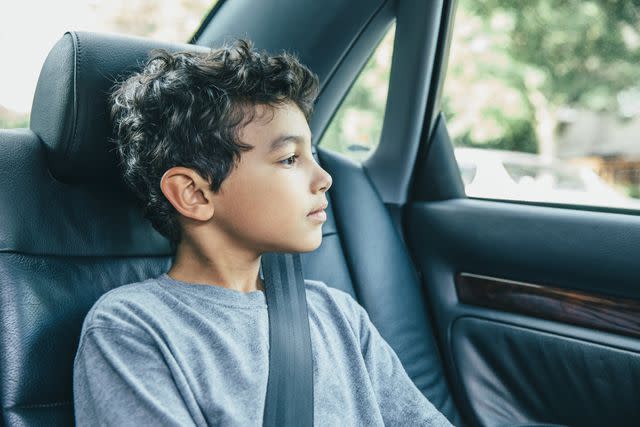When Can My Kid Sit in the Front Seat?
As your child grows older, you might be wondering when kids can sit in the front seat of a car. We turned to pediatricians to learn more about vehicle safety.
Medically reviewed by Lyndsey Garbi, MD
As your child grows, you may start to wonder when it's OK to let them sit in the front seat of your car. Perhaps you're shuttling them from activity to activity, or maybe you've noticed some of their peers sitting in the front seat at school pickup, and you're questioning whether to make the move yourself.
It's important to know that experts recommend waiting until your child is 13 years old before allowing them to sit in the front seat. Their musculoskeletal systems are still developing in the years earlier, making them more vulnerable to injury in a crash.
We reached out to pediatric health experts to learn more about when kids can sit in the front seat, why it's important to wait until the appropriate age, and why it's risky to make the move too early.

Inti St Clair/Getty Images
What Age Can Children Sit in the Front Seat of a Car?
Kids can safely sit in the front seat when they're 13 years old. The American Academy of Pediatrics (AAP) recommends that all children 12 and under sit in the back seat of the car.
Starting from birth, babies should always be buckled securely into a rear-facing car seat. Once they grow out of it, they should sit forward-facing in a car seat until age 5.
Children who have outgrown their car seats will need to use a booster seat until they're tall enough that the shoulder seat belt rests across the center of their chest and shoulder. This generally happens from age 8 to age 12.
States have differing laws on exactly how old a child can be to ride in the front seat, so it's a good idea to check the local guidelines where you live. Regardless, experts recommend waiting until age 13, and at any age, the back seat is always safer.
Related: Mom Is Sharing Her Story to Warn Other Parents About Car Seat Safety
How Much Does a Child Need to Weigh to Sit in the Front Seat?
There's no official weight limit for sitting in the front seat, though some states have set laws on this. Age tends to matter more than weight when it comes to safely riding up front.
Regardless of a child's weight, their bones are still developing and softer than that of an adult. "Seat belts may not stay in appropriate placement in the event of a car crash due to immature pelvic bone development," says Maneesha Agarwal, M.D., a pediatric emergency department physician at Children's Healthcare of Atlanta who specializes in car safety and frequently treats patients who have been involved in accidents.
Risks of Moving a Child to the Front Seat Too Early
The front seat passenger air bag is one of the main reasons that children under age 13 are safer in the back. Air bags are designed to protect the average adult and they deploy at speeds up to 200 miles per hour. "Since children are shorter than adults, the air bag may deploy at the level of their head," says Jennifer McCue, R.R.T., B.S.Ed., C.P.S.T., the injury prevention coordinator at the Trauma Program at Nemours Children's Hospital, Delaware. "This can be extremely dangerous, possibly leading to head or neck injuries, or even death."
Children's skeletal systems are also still developing, which can increase the chance of injuries. Kids' bones are more flexible and less dense than those of adults, putting them at a greater risk. Sitting in the front generally places the child closer to the point of impact in a crash, while the back seat allows for lower impact on their fragile skeletons.
Related: Car Seat Safety Check: 9 Most Common Mistakes to Avoid
Ways to Keep Children Safe in the Front Seat
You might decide to move your child up front when they reach 13, but you may still feel nervous about making the transition. Here are some tips for safe riding in the front seat:
Always ensure that your child's seat belt is buckled the entire time the car is in motion. Do not allow your child to put the shoulder belt under their arm or behind them.
Feet should rest on the floor, not the dashboard.
Use a booster seat if the shoulder belt does not rest across the center of your child's shoulder.
Kids should sit in place rather than moving around. "Remind children not to lean forward to reach for something they might have dropped or turn around to talk to others in the back seat," says McCue. "This puts the seat belt in an incorrect position on their body."
When in Doubt, the Back Seat Is Always Best
By age 13, it's much safer to allow your child to ride up front because they're taller and their bones have become harder and denser. That being said, the back seat is always considered the safest place to ride because it's generally farther from the point of impact in a crash.
"Don't rush for your child to be in the front seat," says Dr. Agarwal. "Make sure your child is mature enough to sit properly in the seat for the entire ride without engaging in potentially dangerous behaviors, like moving the shoulder strap behind them or propping their feet on the dashboard."
So remember, choose the back seat whenever you can, but always for kids age 12 and under.
Related: The Best Booster Seats for Growing Kids
For more Parents news, make sure to sign up for our newsletter!
Read the original article on Parents.

